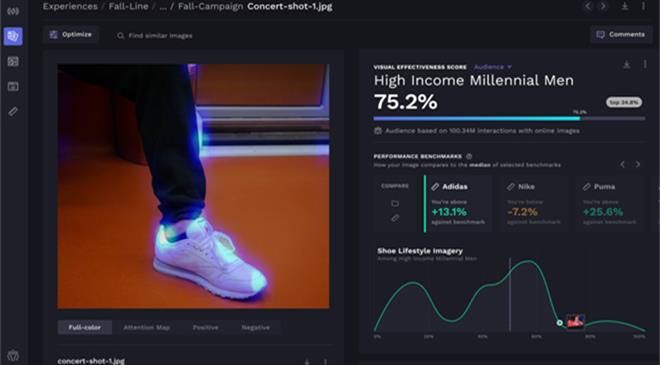Brands reported up to 32% rise in online sales using Vizit
Headquartered in Boston, Massachusetts, Vizit claims to be the world's first visual intelligence company. Founder-chief executive officer (CEO) Jehan Hamedi shares with Paulami Chatterjee how brands using its platform have reported ten times more cost savings compared to traditional consumer research and testing methods, and the improvements planned for the software.
Where is the software installed actually and how does it help monitor visitor habits? Does it link up with other backend softwares?
Vizit provides a cloud-based AI software platform that our customers have access to anywhere in the world using a web browser. Each customer dashboard is fully customised and can be connected with the customer's content libraries and asset management workflows.
What is the story behind formation of brand Vizit? Who are the key people involved? What is their background?
Vizit is the world's first visual intelligence company. Our mission is to bring visual intelligence to everyone and everywhere. Our customers today use Vizit to build and optimise high performance visual brands.
I have more than a decade of experience in computational social science and artificial intelligence (AI). My technology innovations have led to significant advances in AI, consumer insights and ecommerce technology, and my work has resulted in eight patents.
Award-winning AI scientists and market research experts make up our company's product team. They have been at the forefront of next-generation applications of artificial intelligence for the last decade. Our team's forward-thinking, innovative approach to connect AI and computer vision with consumer behaviour led us to develop AI software to unlock the secret of how and why humans develop visual preferences, and effectively analyse images 'through the eye' of any consumer audience in the world.
What is 'visual intelligence'? How is it linked to AI?
Visual intelligence (VI) is an entirely new category of technology, an ensemble of predictive AI and computer vision-based algorithms that measure, score and provide data-driven insights on image and video content. It gives brands the ability to measure and predict the effectiveness of visual content for targeted consumer audiences to present and market products more effectively.
Visual intelligence relies on AI algorithms to replicate the visual preferences of entire consumer audiences. These AI algorithms analyse visual content that audiences encounter online for patterns and visual cues, and then learn from behaviour and engagement patterns to determine an audience's preferences for imagery. As the Vizit platform continues to learn from millions of interactions with visual content every day, our algorithms continue to evolve in tandem with changes in consumer preferences. As such, the ability to generate accurate insights from an audience segment remains relevant over time.
How many customers are registered with you at present? Which are the top names?
Our customer base is growing rapidly and we are working with some of the largest global brands, including Harley Davidson, Reebok and Master Lock among a host of other household names that we cannot yet disclose.
What are some of your key findings with respect to shopping habits of people? How has the pandemic impacted the same?
The pandemic has accelerated the importance of e-commerce for every consumer brand. The biggest trend we have seen is in the production of high-quality visual content because having effective images is now critical in a digital, visual-centered shopping environment. Images have become the gateway to consideration.
Blockchain, AI, VI-new terms that are increasingly becoming part of the industry vocabulary. How could it change the way business is conducted?
Like most industries, the textile, apparel and fabric spaces have an influx of available business intelligence data to optimise everything from marketing results and online sales, to customer experience models and internal workflows. What they don't have is measurable data that can predict how their visual assets will perform. Vizit solves this problem with AI.
The fashion industry is built on images. Websites, social media, online marketplaces, in-store advertisements-every digital touch point imaginable is driven by a brand's visual assets. This is where VI will change the game. VI gives brands powerful insights for every single image they create, not only measuring its effectiveness, but allowing brands to optimise their complete library of e-commerce visual assets in an effort to drive the highest conversion rate and customer experience.
Vizit's platform is changing the way creative teams, marketers, insight teams and e-commerce brands operate, by empowering them to quickly select the images most likely to increase online traffic, drive conversions, and lift revenue numbers, all in record time.
The textile-apparel- fabric space needs a lot of touch and feel. How close can VI come to that?
VI is the only technology available in this space that can predict the impact of an image in e-commerce. Why is this important? Ninety-three per cent of consumers state their purchasing decision is based on the image they see of the product. Images are processed in the human brain 60,000 times faster than text, implying images are one of the key-if not the most valuable-sales assets a company can use to attract and convert consumers.
Has the need for visual branding increased since the pandemic?
It is safe to say the world is not yet considered fully 'post-pandemic,' but the pandemic resulted in major shifts in consumer buying patterns. Last October, eMarketer reported US e-commerce sales would grow by 32.4 per cent year over year and account for more than 14 per cent of all US retail spending. The top ten online retailers were expected to grow their market share by 5 per cent.
That is a lot of money on the table in terms of e-commerce revenue. Brands need actionable insights to remain competitive in this market. VI allows brands to analyse, measure and optimise the most important component of their e-commerce strategy: images.
How much increase in sales have companies reported after installing the software?
Brands that use the platform have reported as much as a 32 per cent increase in online sales after using images selected based on their visual effectiveness score.
How does the software work? How reliable is it considering that the human mind could be somewhere and the eye looking at something else? How do the software cues take all of that into account?
Brands are able to measure, monitor and optimise imagery based on our unique approach to predicting visual effectiveness.
After uploading a visual asset into the Visual Brand Performance platform, our technology analyses the image to compute its visual effectiveness score, a proprietary metric that calculates how effective the image will be at generating interest with a given audience. The score is represented by a numerical percentage between 0 and 100. The higher the score, the more effective the image will be at motivating consumers to view and purchase a product.
Our platform is built on top of the largest repository of consumer visual preference data in the world. Using this proprietary database, our software is able to reliably and accurately surface visual trends and insights that simply were not possible using legacy methods like surveys and focus groups.
How does the software help brands optimise their visual content? What are the metrics used to measure effectiveness? Could you share some examples?
Leading global brands have experienced astounding results immediately after adding our platform to their technology stack, with some customers seeing more than 10 times cost savings compared to traditional consumer research and testing methods.
According to Reebok's Head of Insights, "One of the biggest advantages of Vizit's solution is the efficiency to be able to get reads and insights on all of the images in your brands' visual library".
Pictured below, is a sample of the Visual Brand Performance Platform. Using a Reebok image, the platform can analyse the image and predict how well received the image will be for the specific audience of 'high-income millennial men'-entirely with our proprietary algorithms. With a visual effectiveness score of 75.2 per cent, Vizit's team can see that this is an effective lifestyle image for high-income millennial men, further illustrated by its performance against other brand benchmarks (Adidas, Nike, Puma).
The work Vizit has done with Reebok has helped them streamline their creative process and get to the most impactful images faster. According to the company's head of insights, Vizit's platform added major efficiencies to their process, so that they could easily scan available images to get a quick read on which ones would be more effective across the digital shelf and in digital campaigns.

What is the kind of support and hand holding you provide to your customers?
We offer a high-level of customer support that includes a client services team focused on building ongoing, collaborative relationships. From the initial introductory call, Vizit works in tandem with the customer to help build a visual intelligence programme that will leverage new consumer insights to drive visual brand success. Our client services team consists of incredibly passionate and talented analysts who are VI experts and are able to uncover insights and trends to help increase the effectiveness of a brand's visual assets.
After a customer is up and running on our platform, our client services team continues to work with the customer to share best practices, industry insights and new research to elevate their visual brand in the eyes of their target customers.
Do you plan any improvements in the software?
While we launched the Visual Brand Performance platform globally in January 2021, we are always advancing our AI technology and plan to roll out updates to the dashboard and new product features later this year. Some major updates that were included in this most recent launch were the inclusion of 'attention maps' and 'visual sentiment maps', intuitive image overlays revealing where consumers will look first at an image, and what portions of the image drive and detract from an image's overall effectiveness with an audience.
As a company, how do you plan to grow in future?
Our focus right now is on creating a best-in-class platform that will empower marketing organisations, creative teams, insight teams and e-commerce teams to measure, optimise and monitor their full archive of visual assets and every new asset they produce. Our goal is to broaden our reach and introduce our platform to as many brands as possible. Part of that growth strategy will include publishing frequent category reports and analyses to highlight visual trends and insights in different online consumer categories.
What has been your growth story in the last couple of years?
Just out of the gate, our growth has been explosive. The brands we are working with are immediately seeing the power of our platform, and how it can generate results and drive sales lift. After all, we help our customers see what sells.


